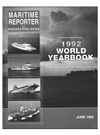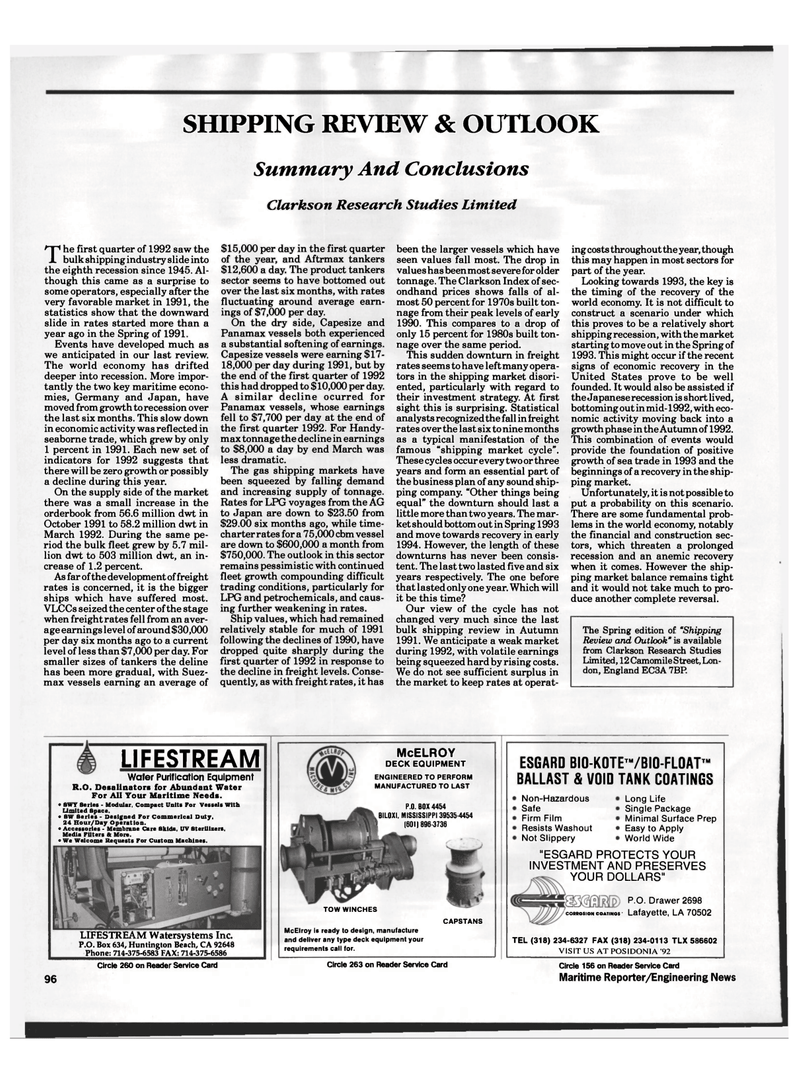
Page 86: of Maritime Reporter Magazine (June 1992)
Read this page in Pdf, Flash or Html5 edition of June 1992 Maritime Reporter Magazine
SHIPPING REVIEW & OUTLOOK
Summary And Conclusions
Clarkson Research Studies Limited
The first quarter of 1992 saw the bulk shipping industry slide into the eighth recession since 1945. Al- though this came as a surprise to some operators, especially after the very favorable market in 1991, the statistics show that the downward slide in rates started more than a year ago in the Spring of 1991.
Events have developed much as we anticipated in our last review.
The world economy has drifted deeper into recession. More impor- tantly the two key maritime econo- mies, Germany and Japan, have moved from growth to recession over the last six months. This slow down in economic activity was reflected in seaborne trade, which grew by only 1 percent in 1991. Each new set of indicators for 1992 suggests that there will be zero growth or possibly a decline during this year.
On the supply side of the market there was a small increase in the orderbook from 56.6 million dwt in
October 1991 to 58.2 million dwt in
March 1992. During the same pe- riod the bulk fleet grew by 5.7 mil- lion dwt to 503 million dwt, an in- crease of 1.2 percent.
As far of the developmentof freight rates is concerned, it is the bigger ships which have suffered most.
VLCCs seized the center of the stage when freight rates fell from an aver- age earnings level of around $30,000 per day six months ago to a current level of less than $7,000 per day. For smaller sizes of tankers the deline has been more gradual, with Suez- max vessels earning an average of $15,000 per day in the first quarter of the year, and Aftrmax tankers $12,600 a day. The product tankers sector seems to have bottomed out over the last six months, with rates fluctuating around average earn- ings of $7,000 per day.
On the dry side, Capesize and
Panamax vessels both experienced a substantial softening of earnings.
Capesize vessels were earning $17- 18,000 per day during 1991, but by the end of the first quarter of 1992 this had dropped to $10,000 per day.
A similar decline ocurred for
Panamax vessels, whose earnings fell to $7,700 per day at the end of the first quarter 1992. For Handy- max tonnage the decline in earnings to $8,000 a day by end March was less dramatic.
The gas shipping markets have been squeezed by falling demand and increasing supply of tonnage.
Rates for LPG voyages from the AG to Japan are down to $23.50 from $29.00 six months ago, while time- charter rates for a 75,000 cbm vessel are down to $600,000 a month from $750,000. The outlook in this sector remains pessimistic with continued fleet growth compounding difficult trading conditions, particularly for
LPG and petrochemicals, and caus- ing further weakening in rates.
Ship values, which had remained relatively stable for much of 1991 following the declines of 1990, have dropped quite sharply during the first quarter of 1992 in response to the decline in freight levels. Conse- quently, as with freight rates, it has been the larger vessels which have seen values fall most. The drop in values has been most severe for older tonnage. The Clarkson Index of sec- ondhand prices shows falls of al- most 50 percent for 1970s built ton- nage from their peak levels of early 1990. This compares to a drop of only 15 percent for 1980s built ton- nage over the same period.
This sudden downturn in freight rates seems to have left many opera- tors in the shipping market disori- ented, particularly with regard to their investment strategy. At first sight this is surprising. Statistical analysts recognized the fall in freight rates over the last six to nine months as a typical manifestation of the famous "shipping market cycle".
These cycles occur every two or three years and form an essential part of the business plan of any sound ship- ping company. "Other things being equal" the downturn should last a little more than two years. The mar- ket should bottom out in Spring 1993 and move towards recovery in early 1994. However, the length of these downturns has never been consis- tent. The last two lasted five and six years respectively. The one before that lasted only one year. Which will it be this time?
Our view of the cycle has not changed very much since the last bulk shipping review in Autumn 1991. We anticipate a weak market during 1992, with volatile earnings being squeezed hard by rising costs.
We do not see sufficient surplus in the market to keep rates at operat- ing costs throughout the year, though this may happen in most sectors for part of the year.
Looking towards 1993, the key is the timing of the recovery of the world economy. It is not difficult to construct a scenario under which this proves to be a relatively short shipping recession, with the market starting to move out in the Spring of 1993. This might occur if the recent signs of economic recovery in the
United States prove to be well founded. It would also be assisted if the Japanese recession is short lived, bottoming outinmid-1992, with eco - nomic activity moving back into a growth phase in the Autumn of 1992.
This combination of events would provide the foundation of positive growth of sea trade in 1993 and the beginnings of a recovery in the ship- ping market.
Unfortunately, it is not possible to put a probability on this scenario.
There are some fundamental prob- lems in the world economy, notably the financial and construction sec- tors, which threaten a prolonged recession and an anemic recovery when it comes. However the ship- ping market balance remains tight and it would not take much to pro- duce another complete reversal.
The Spring edition of "Shipping
Review and Outlook" is available from Clarkson Research Studies
Limited, 12 Camomile Street, Lon- don, England EC3A 7BP.
LIFESTREAM
Wafer Purification Equipment
R.O. Desalinators for Abundant Water
For All Tour Maritime Needs. • SWT 8eries - Modular, Compact Units For Vessels With
Limited Space. • SW Series - Designed For Commerlcal Duty, 24 Hour/Day Operation. • Accessories - Membrane Care Skida, UV Sterilizers,
Media Filters & More. • We Welcome Requests For Custom Machines.
LIFESTREAM Watersystems Inc.
P.O. Box 634, Huntington Beach, CA 92648
Phone: 714-375-6583 FAX: 714-375-6586
Circle 260 on Reader Service Card
MCELROY
DECK EQUIPMENT
ENGINEERED TO PERFORM
MANUFACTURED TO LAST
P.O. BOX 4454
BILOXI, MISSISSIPPI 39535-4454 1601) 896-3736
TOW WINCHES
McElroy Is ready to design, manufacture and deliver any type deck equipment your requirements call for.
CAPSTANS
Circle 263 on Reader Service Card
ESGARD BI0-K0TE™/BI0-FL0AT™
BALLAST & VOID TANK COATINGS
Non-Hazardous
Safe
Firm Film
Resists Washout
Not Slippery
Long Life
Single Package
Minimal Surface Prep
Easy to Apply
World Wide "ESGARD PROTECTS YOUR
INVESTMENT AND PRESERVES
YOUR DOLLARS"
P.O. Drawer 2698 corrosion coatings Lafayette, LA 70502
TEL (318) 234-6327 FAX (318) 234-0113 TLX 586602
VISIT US AT POSIDONIA '92 96
Circle 156 on Reader Service Card
Maritime Reporter/Engineering News

 85
85

 87
87
